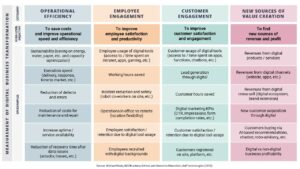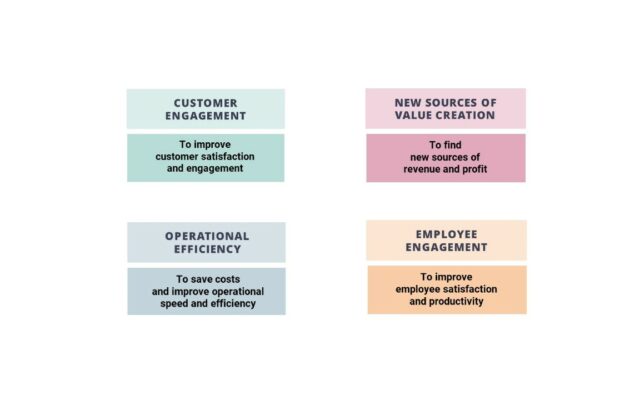In our 2021 article “Measuring Digital Transformation”[1], we argued that the application of appropriate KPIs (key performance indicators) is essential for the success of digital transformation initiatives. Further research[2] and experience continue to support the importance of measurement, and also highlight the challenges of finding and applying the right measures. Therefore, we developed a comprehensive KPI taxonomy to help organizations move from ‘what’ to ‘how’ when it comes to assessing their transformation journeys.
Why Measures Matter
One of the main causes of digital transformation failure is the lack of clear objectives. We often see organizations pursuing digital solely for the sake of digital, rather than carefully considering the benefits that digital technologies can bring. Objectives need to be specified and measured. Progress towards these goals must be assessed so that appropriate adjustments can be made and resources reallocated along the way, based on real numbers. Thankfully, digital projects lend themselves well to measurement since they can generally be quantified. This data can in turn show to skeptical executives the value created. “Good numbers” are key to winning the intra-organizational competition for budgets and other limited resources, and for securing management support.
24 Digital Transformation KPIs
Our taxonomy of 24 digital transformation KPIs encompasses four categories (see Table 1). Two categories – Operational Efficiency and Employee Engagement – are largely inward-facing, while the other two – Customer Engagement and New Sources of Value Creation – are outward-facing. These categories represent the main areas where digital can create value – through improved operations and efficiency on one side, and enhanced revenues on the other.
Operational Efficiency
The measures in this category refer to cost-saving and improvements in speed and efficiency. They include measures to: increase execution speed, reduce errors, reduce maintenance costs, increase service availability, reduce cyber-attack recovery time, and enhance sustainability. Some examples of how these measures can lead to positive benefits are shown below.
Execution speed refers to reducing the time needed for key activities. GE Healthcare Japan[3] is active in radiology and medical imaging – it utilizes digital technologies to provide accurate diagnostic services and recommend treatments. GE Healthcare Japan was able to reduce the time from order receipt to fulfillment from one and a half months to less than one month, by adopting embedded and edge solutions to bring computation and storage closer to the data sources.
Digital technologies can also be used to reduce defects and errors. The Airbus Group[4] adopted wearables (smart glasses using contextual marking instructions) on the assembly line, reducing its error rate to zero. The reduction of errors/defects is a valuable KPI to measure digital transformation.
As being “always on” has become a must, organizations rely heavily on digital technologies to maximize uptime (the time during which a piece of equipment is functioning). Equipment downtime may mean that important services become unavailable, including access to high-value data. Under Armour[5], for example, has put data at the center of product development and innovation, through its Connected Fitness application. The company has invested in more dependable and streamlined access to high-value data, achieving 100% uptime within an infrastructure that protects 300 applications and 1,000 virtual machines, and is replicated across two data centers hundreds of kilometers apart.
Sustainability objectives are increasingly linked with digital transformation. Depending on the industry, this can focus on different aspects of sustainability, from the savings on energy, water, or paper, to space optimization and more. AeroFarms[6] is active in indoor vertical farming. Leveraging digital solutions such as advanced IoT and data analytics, the company carefully measured the effects of its technology innovations on its impact on the planet. The company saw a 95% saving on water compared to conventional farming, with yields up to 390 times higher.
Employee Engagement
This category focuses on the improvement of employee satisfaction and productivity. Measures relate to: employee usage of digital tools, hours of work saved, reduction in safety incidents, extent of remote work, satisfaction with digital tools, and employee recruitment and retention. Some examples are provided below.
A powerful KPI relates to working hours saved due to the use of digital technologies. Document management[7] is an obvious case, as research has shown that simply digitizing data collection can save 528 hours per employee per year. Furthermore, when L’Oreal Paris[8] adopted the chatbox Mya, they found that up to 75% of questions people have during the recruiting process were automatically addressed, saving the UK team 45 days of work over 6 months.
Employee incident reduction is an important KPI to assess a successful digital transformation. When Faurecia Interior Systems and OTTO Motors[9] partnered on integrating robot co-workers in manufacturing premises, the result was zero accidents involving humans or near-miss incidents.
Unilever[10] wanted to simplify the way employees found information across processes, systems and content resources, freeing up support agents’ time for higher-value human interactions. Hence, the company decided to reimagine the overall employee experience around three pillars: human experiences, simple interactions, meaningful impact. The vision converged on a tool that integrated “Una”, a chatbot operating as a personal assistant to guide employees, and whose conversations were continuously improved through a built-in learning loop. “Una” was tested and fine-tuned in a pilot project, immediately obtaining a rating of 4.6/5 and 85% employee satisfaction.
Customer Engagement
This category refers to improvement in customer satisfaction and interactivity. Measures include: customer usage of digital tools, increase in lead generation, customer hours saved, various digital marketing KPIs, customer retention, and platform registrations.
In our previous article, we described how Singapore-based bank DBS developed the “customer hours” concept to save customer’s time. Here, we would like to provide some other examples of how organizations have used measures to drive customer engagement as part of their digital transformation.
Actual customer use of digital tools (not just an app download) is an important KPI to measure digital transformation. Yum China[11] operates KFC, Pizza Hut and Taco Bell restaurants thanks to its exclusive license. Its rapid expansion and high popularity have meant long lines for customers in many restaurants, with a negative impact on revenue maximization. To address the issue, Yum China built a mobile ordering system with multiple functions. Since the launch, the app has been downloaded by over 8 million devices and is registering more than 200,000 mobile orders daily. Yum China has also seen a 15% revenue boost (plus a 30% cost reduction).
In financial services, Polish bank PKO Bank Polski[12] launched a mobile application to reach new – especially younger – customers. The app quickly became the most popular mobile banking application in the country thanks to very high customer ratings of 4.7 out of 5. Indeed, in 2018, the app was voted the best mobile banking app worldwide. PKO continues to innovate: in late 2021, it introduced a new contactless payment system processing more than 30,000 transactions per day[13].
Lead generation through digital is another important KPI. When Italy’s UBI Banca[14] needed to find new leads in the highly competitive mortgage market, it created a Center of Digital Excellence with a content factory and a comprehensive marketing strategy. The result was 8 times more leads generated (with a 66% decrease in costs for lead generation and 25% increase in organic web traffic).
New Sources of Value Creation
New value creation aims at finding innovative ways to increase revenues and profits. Measures include: revenues from digital offerings and channels, digital cross-selling effectiveness, new customer acquisition, effectiveness of digital advisory tools, and digital business profitability.
A KPI measuring revenue from digital products or services is important even for organizations with a non-digital origin. The New York Times[15] introduced a paywall for digital in 2011, with news subscriptions bundled with access to other digital-only products, and with standalone subscriptions for elements such as games, cooking, and audio. Since the introduction of the paywall, the number of paid digital-only subscriptions has grown from about 0.5 to 7.5 million. In 2020, for the first time, the New York Times reported higher revenues from its digital business than its print operations.[16]
Information can be digitized, but the same is not easily true for physical objects such as consumer goods; nevertheless, digital can be a powerful channel to boost revenues. 18 months after illycaffè[17], an Italian coffee brand, re-designed its entire digital customer experience from website to social media channels and customer care, the company saw a 24% improvement in site revenues from SEO activities, as well as a 15% increase in social media reach and engagement.
Digital transformation allows organizations to re-invent the concept of cross-selling by building new ecosystems or boosting brand extensions. Amazon[18] is often quoted as an archetype, but there are many more cases. Insurance company Baloise[19] invested in a digital platform that enables consumers, insurers, agents/brokers, vendors, and other participants to interact along the insurance process anywhere and at any time. A quantitative KPI measuring the change in new business issued by brokers saw an increase of 50% following the introduction of the platform.
In the fashion industry, the customers of Stitch Fix[20] buy via digital advisory tools. By completing a “style profile”, they provide on average over 100 data points, like detailed style, size, price preferences and which parts of their bodies they like to flaunt. This is also reflected in revenue from digital services, as the company offers a yearly subscription to a “Style Pass” for a $49 fee.
Table 1 – Digital Transformation KPI Taxonomy

Measure in a holistic way
Not all the proposed KPIs are needed for every digital transformation. However, we recommend adopting measures across the categories (breadth) in addition to within a category (depth). One of the main failure points comes from not considering the wider implications – breadth matters.
Even when the necessary data is not available, organizations should make an extra effort to set-up a first version of the KPIs. Measures may start off as percentage improvements or absolute gains, and they can be fine-tuned in time, based on additional findings, resources, results obtained and evolving needs – the measurements don’t need to be perfect right from the start.
Importantly, KPIs should be adopted before the transformation project is initiated. Simply hoping for good numbers ‘after the fact’ greatly reduces the chances of a successful digital transformation.
The era of digital disruption is far from over, as evidenced by the corporate longevity of S&P 500 firms – companies continue to drop off the index, as new, disruptive entrants join.[1] In our previous article, we revealed that 87% of digital transformation projects fail; evidence across all sectors, from consumer products to industrial goods, show that this continues to be the case. We believe that being able to effectively measure progress can have a strong, positive effect on any digital transformation.
About the Authors
Michael Wade is a professor of Innovation and Strategy at the IMD Business School
Massimo Marcolivio is a Marketing Manager at Dell Technologies
[1] https://www.innosight.com/insight/creative-destruction/
[1] https://www.thedigitaltransformationpeople.com/channels/delivery/measuring-digital-transformation/
[2] https://www.linkedin.com/feed/update/urn:li:activity:6838117799609585664
[3] https://www.delltechnologies.com/asset/en-gb/solutions/industry-solutions/customer-stories-case-studies/2016-ge-healthcare-10022699-vrtx-oem-converged.pdf
[4] https://www.accenture.com/ch-en/case-studies/aerospace-defense/airbus-wearable-technology
[5] https://www.delltechnologies.com/asset/en-gb/products/data-protection/customer-stories-case-studies/dell-emc-customer-profile-under-armour.pdf
[6] https://www.aerofarms.com/how-we-grow/ ; https://www.delltechnologies.com/asset/en-gb/products/ready-solutions/customer-stories-case-studies/dell-aerofarms-case-study.pdf
[7] https://www.xerox.com/en-us/office/insights/small-business-digital-transformation
[8] https://www2.deloitte.com/content/dam/Deloitte/pl/Documents/Prezentacje-webinary/pl_26_10_2021_webinar_HR_Transformation.pdf
[9] https://ottomotors.com/resources/videos/faurecia-video
[10] https://www.accenture.com/ch-en/case-studies/interactive/unilever-reimagining-employee-experience
[11] https://dxc.com/us/en/insights/customer-stories/Mobile-food-ordering-enhances-customer-service-and-revenue-for-Yum-China
[12] https://dxc.com/us/en/insights/customer-stories/pko-bank-polski-establishes-market-leadership-with-online-mobile
[13] https://techartica.com/pko-bp-clients-made-1000000-contactless-transactions-with-blik/
[14] https://www.accenture.com/ch-en/case-studies/digital/ubi-banca-digital-mortgage-leads
[15] https://www.statista.com/chart/3755/digital-subscribers-of-the-new-york-times/?utm_source=Statista+Newsletters&utm_campaign=17a2325492-All_InfographTicker_daily_COM_AM_KW03_2022_Tu_COPY&utm_medium=email&utm_term=0_662f7ed75e-17a2325492-315156169
[16] https://www.cnbc.com/2020/08/05/nyt-ceo-mark-thompson-on-digital-revenue-topping-print-for-first-time.html
[17] https://www.accenture.com/ch-en/case-studies/digital/illycaffe-perfecting-digital-customer-experience
[18] https://www.statista.com/chart/15917/amazon-revenue-by-segment/
[19] https://dxc.com/us/en/insights/customer-stories/Digital-insurer-Baloise-builds-future-on-DXC-Assure-Digital-Platform
[20] https://investors.stitchfix.com/static-files/f6bf1683-52ac-4d85-a98a-68e161592654
Article by channel:
Everything you need to know about Digital Transformation
The best articles, news and events direct to your inbox
Read more articles tagged:






